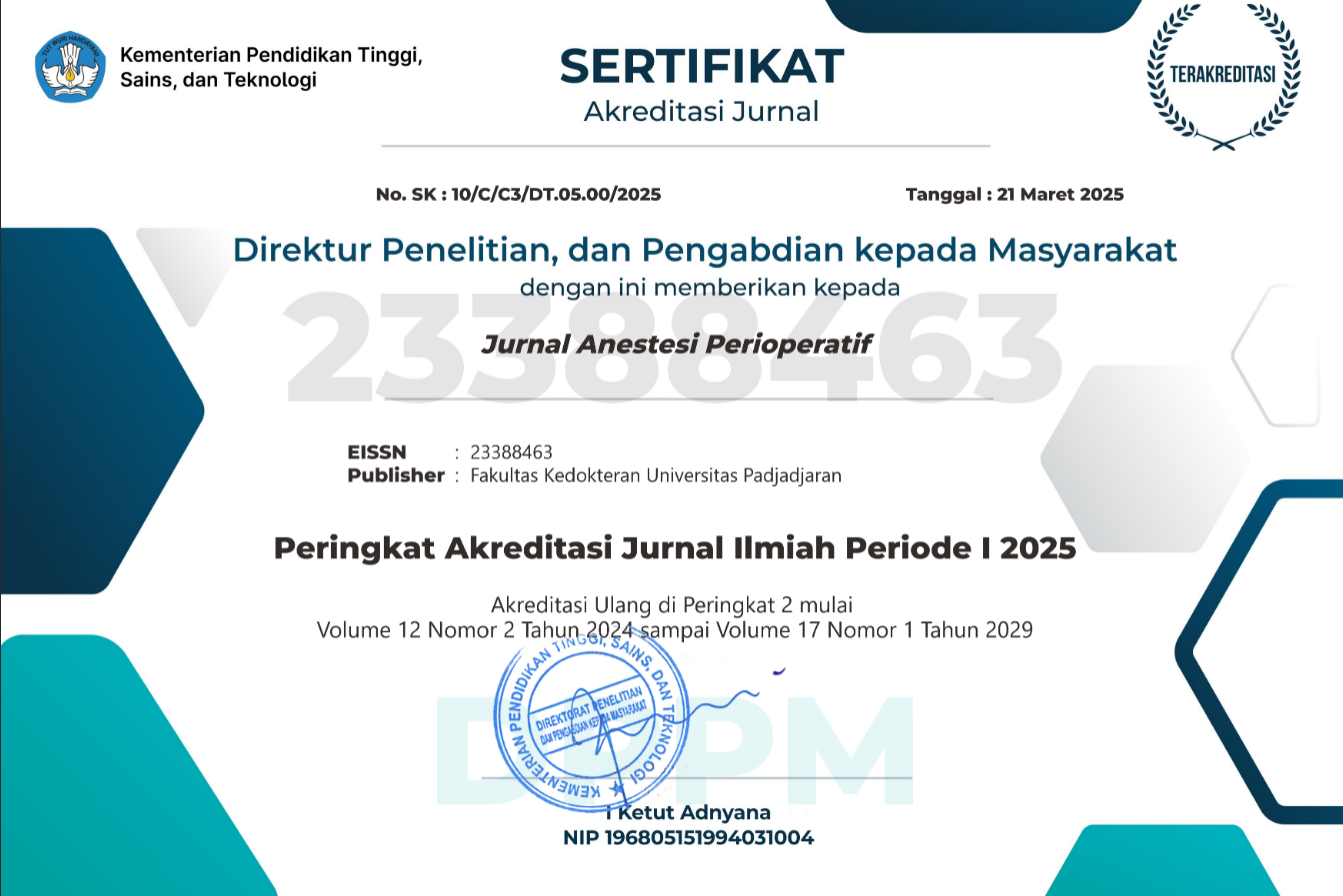Efek Pemberian Positive End Expiratory Pressure 5 cmH2O terhadap Perubahan Nilai Forced Expiratory Volume in 1 Second dan Forced Vital Capacity pada Pasien Pascaoperasi Ortopedi
Abstract
Prinsip lung protective ventilation merupakan strategi ventilasi intraoperasi yang direkomendasikan untuk mencegah komplikasi paru pascaoperasi. Penelitian ini bertujuan mengetahui efek pemberian PEEP 5 cmH2O terhadap nilai FEV1 dan FVC pada pasien pascaoperasi ortopedi. Penelitian dilakukan terhadap 54 pasien yang dibagi menjadi 2 kelompok, yaitu kelompok PEEP 5 dan kelompok kontrol (PEEP 0). Penelitian eksperimental ini menggunakan desain single-blind randomized controlled trial dan melibatkan 54 pasien yang dilakukan operasi ortopedi di RSUP Dr. Hasan Sadikin Bandung pada bulan Oktober 2021–Januari 2022. Analisis statistik menggunakan uji T tidak berpasangan dan Uji Mann-Whitney. Hasil penelitian ini menunjukkan bahwa pada kelompok PEEP 5 terjadi penurunan nilai FEV1 lebih rendah dengan rerata –0,17±0,123 dibanding dengan kelompok kontrol (PEEP 0) sebesar -0,49±0,237. Pada kelompok PEEP 5 terjadi penurunan nilai FVC yang lebih rendah dengan rerata -0,20±0,132 dibanding dengan kelompok kontrol (PEEP 0) sebesar -0,60±0,23. Terdapat perbedaan yang signifikan secara statistik antara kelompok PEEP 5 dan PEEP 0 (p<0,05). Simpulan penelitian ini adalah perubahan penurunan nilai FEV1 dan FVC pada pasien pascaoperasi ortopedi dengan pemberian PEEP 5 cmH2O lebih rendah dibanding dengan kelompok kontrol (PEEP 0).
Effects of Positive End Expiratory Pressure cmH2O on Changes in Forced Expiratory Volume in 1 Second and Forced Vital Capacity Values in Post Orthopedic Surgery Patients
The principle of protective lung ventilation is the recommended ventilation strategy to prevent postoperative pulmonary complications. This study aimed to determine the effect of Positive End Expiratory Pressure (PEEP) 5 cmH2O on Forced Expiratory Volume in 1 second (FEV1) and Forced Vital Capacity (FVC) post orthopedic surgery patients. The study was conducted on 54 patients divided into two groups: the PEEP 5 group and the control group (PEEP 0). This experimental study used a single-blind randomized controlled trial design involving 54 patients undergoing orthopedic surgery at dr. Hasan Sadikin General Hospital Bandung between October 2021–January 2022. Statistical analysis was performed using the unpaired T-test and Mann-Whitney test. Study results revealed that in the PEEP 5 group, there was a smaller decrease of FEV1 values, with an average of -0.17±0.12 compared to the control group (PEEP 0) of -0.49±0.23. In the PEEP 5 group, there was a smaller decrease in the FVC value with an average of -0.20 ± 0.13 compared to the control group (PEEP 0) of -0.60±0.23. There was a statistically significant difference between the PEEP 5 and PEEP 0 groups with (p<0.05). This study concludes that the decrease in FEV1 and FVC values in post orthopedic surgery patients with PEEP 5 cmH2O is lower than the control group (PEEP 0).
Keywords
Full Text:
PDFReferences
- Christopher M. Differential efects of intraoperative positive end-expiratory pressure (PEEP) on respiratory outcome in major abdominal surgery versus craniotomy. Physiol Behav. 2016;176(1):100–6.
- Pi X, Cui Y, Wang C, Guo L, Sun B, Shi J, dkk. Low tidal volume with PEEP and recruitment expedite the recovery of pulmonary function. Int J Clin Exp Pathol. 2015;8(11):14305–14.
- Jaber S, Coisel Y, Chanques G, Futier E, Constantin JM, Michelet P, dkk. A multicentre observational study of intra-operative ventilatory management during general anaesthesia: tidal volumes and relation to body weight. Anaesthesia. 2012;67(9):999–1008.
- Kiss T, Wittenstein J, Becker C, Birr K, Cinnella G, Cohen E, dkk. Protective ventilation with high versus low positive end-expiratory pressure during one-lung ventilation for thoracic surgery (PROTHOR): study protocol for a randomized controlled trial. Trials. 2019;20(1):1–21.
- Walkey AJ, Del Sorbo L, Hodgson CL, Adhikari NK, Wunsch H, Meade MO, dkk. Higher PEEP versus lower PEEP strategies for patients with acute respiratory distress syndrome: a systematic review and meta-analysis. Ann Am Thorac Soc. 2017;14:297–303.
- Bluth T, Serpa Neto A, Schultz MJ, Pelosi P, Gama de Abreu M, Bobek I, dkk. Effect of intraoperative high positive end-expiratory pressure (PEEP) with recruitment maneuvers vs low PEEP on postoperative pulmonary complications in obese patients: a randomized clinical trial. JAMA. 2019;321(23):2292–305.
- Graham BL, Steenbruggen I, Barjaktarevic IZ, Cooper BG, Hall GL, Hallstrand TS, dkk. Standardization of spirometry 2019 update an official American Thoracic Society and European Respiratory Society technical statement. Am J Respir Crit Care Med. 2019;200(8):70–88.
- Oh TK, Park IS, Ji E, Na HS. Value of preoperative spirometry test in predicting postoperative pulmonary complications in high-risk patients after laparoscopic abdominal surgery. PLoS One. 2018;13(12):1–10.
- Deng QW, Tan WC, Zhao BC, Wen SH, Shen JT, Xu M. Intraoperative ventilation strategies to prevent postoperative pulmonary complications: a network meta-analysis of randomised controlled trials. Br J Anaesth. 2020;124(3):324–35.
- Chiumello D, Coppola S, Froio S. Toward lung protective ventilation during general anesthesia: a new challenge. Rev Esp Anestesiol Reanim. 2013;60(10):549–51.
- Barbarosa F, Castro A, de Sousa-Rodrigues C. Positive end-expiratory pressure (PEEP) during anaesthesia for the prevention of mortality and postoperative pulmonary complications. Cochrane Database Syst Rev. 2014;(3)7.
- Young CC, Harris EM, Vacchiano C, Bodnar S, Bukowy B, Elliott RRD, dkk. Lung-protective ventilation for the surgical patient: international expert panel-based consensus recommendations. Br J Anaesth [Internet]. 2019;123(6):898–913.
- Wiesen J, Ornstein M, Tonelli AR, Menon V, Ashton RW. State of the evidence: mechanical ventilation with PEEP in patients with cardiogenic shock. Heart. 2013;99(24):1812–7.
- Newman B, Krane EJ, Gawande R, Holmes TH, Robinson TE. Chest CT in children: anesthesia and atelectasis. Pediatric Radiol. 2014;44(2):164–72.
DOI: https://doi.org/10.15851/jap.v10n3.2856
Article Metrics
Abstract view : 929 timesPDF - 641 times
This Journal indexed by

JAP is licensed under a Creative Commons Attribution-NonCommercial 4.0 International License
View My Stats



